
The Thompson submachine gun is an American submachine gun invented by John T. Thompson in 1918 which became infamous during the Prohibition era, being a signature weapon of various crime syndicates in the United States. It was a common sight in the media of the time, being used by both law enforcement officers and criminals. The Thompson submachine gun was also known informally as the "Tommy Gun", "Annihilator", "Chicago Typewriter", "Italian Typewriter", "Chicago Piano", "Chicago Style", "Chicago Organ Grinder", "Trench Broom", "Trench Sweeper", "The Chopper", and simply "The Thompson".
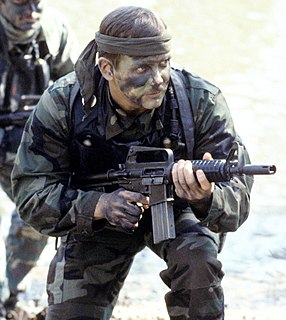
The Colt Automatic Rifle-15 or CAR-15 was a family of M16 rifle based firearms marketed by Colt in the 1960s and early 1970s. However, the term "CAR-15" is most commonly associated with the Colt Commando(AKA: XM177); these select-fire carbines have ultrashort 10.5-inch (270 mm) and 11.5-inch (290 mm) barrels with over-sized flash suppressors.

The Nambu pistols were a series of semi-automatic pistols produced by the Japanese company Koishikawa Arsenal later known as the Tokyo Artillery Arsenal. The series had five variants, the Type A Model 1902, the Type A Model 1902 Modified, the Type B, the Type 14 (南部十四年式自動拳銃) and the Type 94. The pistols were designed by Kijiro Nambu and saw extensive service during the Russo-Japanese War, Second Sino-Japanese War and World War II. The Type A was made in very small numbers. Type A Modified and Type B Nambus were never formally adopted by any branch of the armed forces of Imperial Japan but were sold to officers through officer stores. The Type 14 was adopted as an official sidearm. As World War II progressed, and particularly in the final year of the war, in order to speed production, Type 14s began to be more hastily manufactured with a subsequent decline in quality.

Kijirō Nambu was a career officer in the Imperial Japanese Army and the founder of Nambu Arms Manufacturing Company, manufacturer of many of the firearms the Japanese military would use in World War II. A prolific small arms designer, he was sometimes called the "John Browning of Japan". He was awarded the Order of the Sacred Treasure in 1914.

The Type 100 submachine gun was a Japanese submachine gun used during World War II, and the only submachine gun produced by Japan in any quantity. It was made in two basic variants referred to by American and British observers as the Type 100/40 and the Type 100/44, the latter also known as the Type 100 (Simplified). A third variant was a folding version of the early model, sometimes referred to as the Type 100 Navy, made for parachutists.

The Type 99 rifle Arisaka or Type 99 short rifle was a bolt-action rifle of the Arisaka design used by the Imperial Japanese Army during World War II.
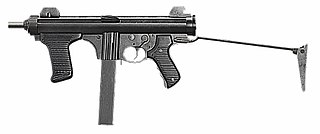
The Beretta Model 12 is a 9×19mm Parabellum caliber submachine gun designed by Beretta. The production started in 1962, the first users were the Italian Carabinieri and the Italian State Police even though in limited number, only in 1978 it was widely issued replacing the old Beretta MAB. In 1962 the Italian Army bought a limited number of Franchi LF57 submachine gun, judged better than the M12 but never issued to the troops, and only in 1992 the M12S2 variant was introduced also if in very limited number. The Italian Air Force, instead, bought a large number of M12S and M12S2 for the airport security units. However the weapon had a higher initial success in the Arab countries and South America. Its debut in combat came during the Tet Offensive in 1968 when the Marines guarding the U.S. embassy in Saigon repelled the assault by the Viet Cong using the Beretta M12. It is also used by various South American, African and Asian countries, and made under licence in Brazil by Taurus, in Belgium by FN Herstal and in Indonesia by PT Pindad.
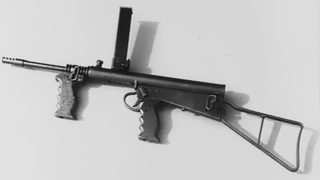
The Owen Gun, which was known officially as the Owen Machine Carbine, was an Australian submachine gun designed by Evelyn (Evo) Owen in 1939. The Owen was the only entirely Australian-designed and constructed service submachine gun of World War II and was used by the Australian Army from 1943 until the mid-1960s.
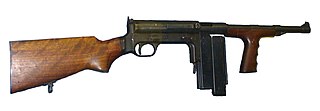
The United Defense M42, sometimes known as the Marlin for the manufacturer, was an American submachine gun in World War II. It was produced from 1942 to 1943 by United Defense Supply Corp. for possible issue as a replacement for the Thompson submachine gun and was used by agents of the Office of Strategic Services (OSS).

The 8×22mm Nambu is a rimless, bottleneck handgun cartridge introduced in Japan in 1904.
Taiyuan Arsenal was established by the Shanxi warlord, Yan Xishan. He had become the Governor-General of Shanxi province in 1912. From the outset he was very interested in building an arsenal for manufacturing weapons to equip his Army. His motto was, "Armed force is the backing of justice". Construction on his plant was begun in 1912, and it was originally named Shanxi Machinery Bureau. As it expanded, it later became known as the Shanxi Military Technology Practice Factory.

The Mendoza RM2 was a light machine gun similar to the M1918 BAR manufactured in Mexico by Productos Mendoza, S.A.. Rafael Mendoza have been producing machine guns for the Mexican Army since 1933 and all have been noted for their lightness and cheap construction without sacrificing reliability.
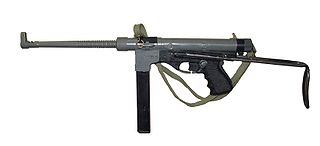
The Vigneron is a submachine gun manufactured in Belgium during the 1950s. It used the 9×19mm NATO cartridge and was used by the Belgian Army until the 1980s. The Vigneron is a selective-fire weapon for short-range street and brush fighting. It remains reasonably accurate up to 100 m using sighted semi-automatic fire. For close-range combat, 2- or 3-shot bursts are recommended.
This is an (incomplete) list of former equipment used by the Estonian Army (Maavägi:) prior to World War 2.
The Experimental Model 2 Submachine Gun was a pre-World War II submachine gun of Japanese origin chambered in the 8mm Nambu round and was issued to Japanese Naval units, and used through until the end of the war.

The M3 is an American .45-caliber submachine gun adopted for U.S. Army service on 12 December 1942, as the United States Submachine Gun, Cal. .45, M3. The M3 was chambered for the same .45 ACP round fired by the Thompson submachine gun, but was cheaper to produce and lighter, although, contrary to popular belief, it was less accurate. This myth stems from a US Army training film portraying the M3 as more accurate than its counterparts. The M3 was commonly referred to as the "Grease Gun" or simply "the Greaser," owing to its visual similarity to the mechanic's tool.

The PPS is a family of Soviet submachine guns chambered in 7.62×25mm Tokarev, developed by Alexei Sudayev as a low-cost personal defense weapon for reconnaissance units, vehicle crews and support service personnel.
















